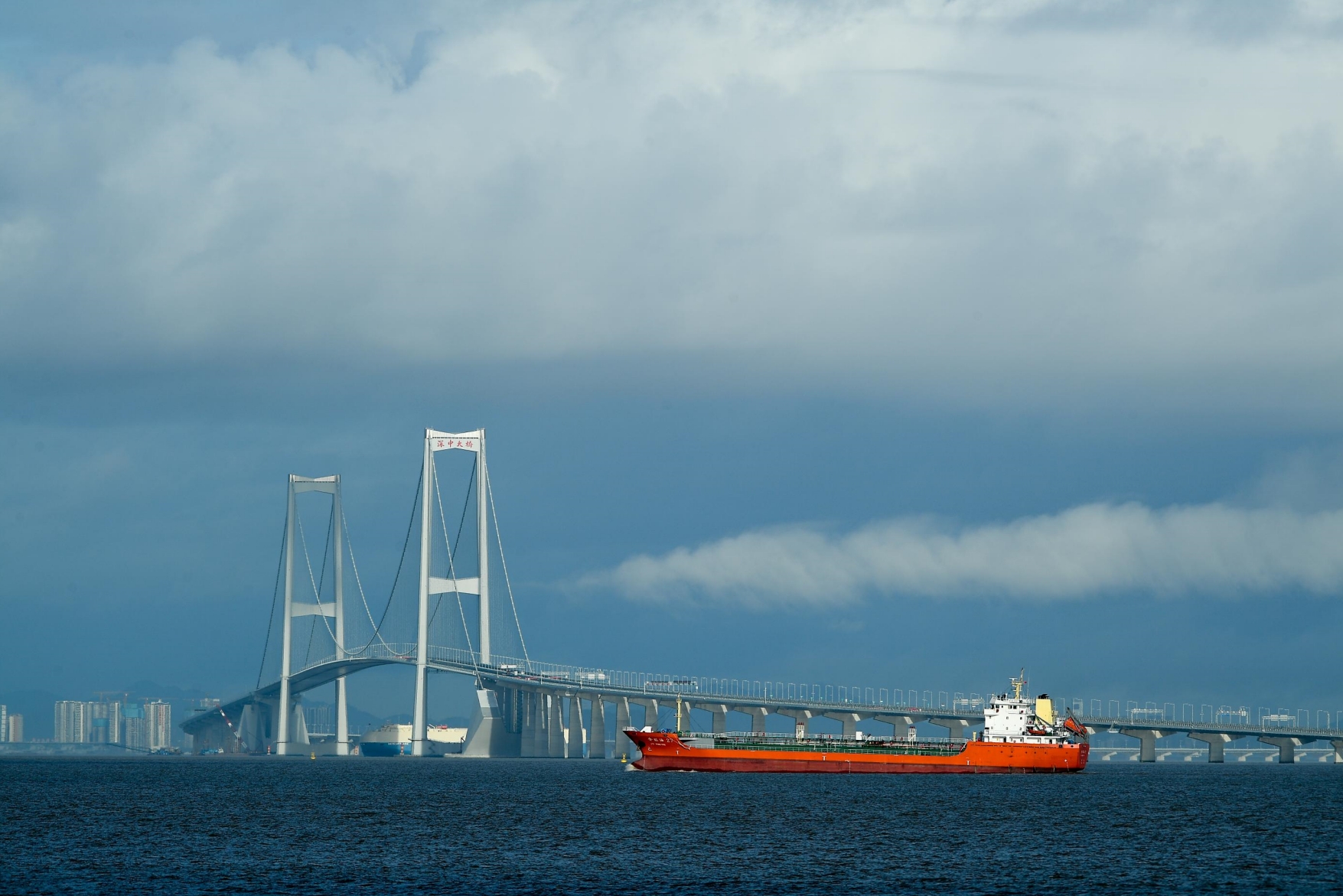
As the Shenzhen-Zhongshan Link opens to traffic, Ma Dingqiang, the project manager of the Bridge at China Communications Construction Company Guangzhou Dredging Co., Ltd. (CCCC Guangzhou Dredging Co.), shared an untold detail with Yangcheng Evening News. During the excavation of the trench and the dredging of the channel for the immersed tunnel of the Shenzhen-Zhongshan Link, the project team abandoned the traditional, more economical, and faster blasting method. Instead, they adopted a rock drilling construction method that is more environmentally friendly, costing an additional 30 million yuan to protect the habitat of the Chinese white dolphins.
The Shenzhen-Zhongshan Link is a world-class cross-sea passage integrating bridges, islands, tunnels, and underwater interchanges. It has set records such as the world's longest dual eight-lane underwater immersed tunnel and the world's widest underwater steel-shell-concrete immersed tunnel. Its underwater tunnel is approximately 6.8 kilometers long, with the immersed tube section about 5 kilometers.
Ma Dingqiang's team at CCCC Guangzhou Dredging Co. was mainly responsible for the excavation of the trench and the dredging of the channel for the immersed tunnel. He explained, "Previously, we also handled the excavation of the trench and the dredging of the channel for the immersed tunnel of the Hong Kong-Zhuhai-Macao Bridge. However, there is a major difference underwater between the two bridges. The tunnel area of the Hong Kong-Zhuhai-Macao Bridge was mostly covered with silt, clay, and sand, which are conventional soil types. In contrast, the Shenzhen-Zhongshan Bridge's immersed tube area contains nearly 300,000 cubic meters of weathered granite."
"Our task in the construction of the immersed tube tunnel is to excavate the bed for the placement of the immersed tubes. The most challenging thing is the excavation of the weathered rock in the immersed tube trench, with the deepest excavation point reaching approximately -38 meters, and even deeper with the tide," said Ma. "Among the nearly 300,000 cubic meters of granite, there are 20,000 cubic meters of moderately weathered granite, which is the hardest to deal with during dredging and considered a hard nut to crack."
Ma informed the reporter that the most efficient, economical, and conventional method to handle such rock using traditional dredging methods is blasting. However, the construction site is located at the Pearl River Estuary, which is a migratory route and an important habitat for the Chinese white dolphins. Blasting would undoubtedly destroy the living environment of the Chinese white dolphins. Using an uncommon rock drilling method instead of blasting would increase costs and potentially delay the construction schedule. "We compared the costs of the two methods and found that using the rock drilling method would increase costs by over 30 million yuan."
Should they use blasting or switch to rock drilling? After comparison and discussion, the project team ultimately decided to discontinue the blasting plan and adopt the more environmentally friendly rock drilling method, using a 35-ton rock drilling rod for deep-water rock drilling.
Ma is glad that the project team chose this method. During the construction, he sometimes saw Chinese white dolphins leaping out of the water while on the ship and would take out his phone to record small videos. He has already done so several times.
According to public reports, the Shenzhen-Zhongshan Link also adopted other measures during its construction to protect the marine ecological environment. The construction team even set a record for fast island formation to reduce the impact on the Chinese white dolphins and manufacture various large components in factories before transporting them for offshore installation to minimize waste emissions.
Source: Yangcheng Evening News
多花3000多万元,深中通道为中华白海豚“让步”
在深中通道通车之际,中交广州航道局有限公司(以下简称“中交广航局”)深中通道项目经理马定强向羊城晚报记者讲述了施工中一个鲜为人知的细节:在深中通道沉管隧道基槽开挖和航道疏浚过程中,为保护中华白海豚的生活环境,项目部放弃了传统的、更为经济快捷的爆破方式,采用对生态环境更为友好的凿岩施工工艺,为此多花费3000多万元。
深中通道是集“桥、岛、隧、水下互通”于一体的世界级跨海通道集群工程,创下世界最长双向八车道海底沉管隧道、世界最宽海底钢壳-混凝土沉管隧道等纪录,它的海底隧道长约6.8公里,其中沉管段约5公里。

马定强所在的中交广航局主要负责深中通道沉管隧道的基槽开挖及航道疏浚工作。他介绍:“之前港珠澳大桥的沉管隧道基槽开挖和航道疏浚也是我们做的,但深中通道与港珠澳大桥在水下的最大不同在于,港珠澳大桥的沉管隧道区域分布的大多是淤泥、黏土跟沙,是常规土质,而深中通道沉管区域分布着将近30万立方米的风化花岗岩。”
“我们在沉管隧道施工的任务就是要把供沉管安放的基床给挖出来。施工中难度最大的是沉管基槽风化岩的开挖,最大挖深处标高约-38米,如果加上潮水,水深更高。”马定强说,“在将近30万立方米的花岗岩中,中风化花岗岩占了2万立方米,而中风化花岗岩在疏浚中最难处理,属于‘硬骨头’。”
马定强告诉记者,如果按传统疏浚办法,处理这种岩石最高效、最经济、最常规的方式是爆破,但施工现场位于珠江口,是中华白海豚的洄游区和重要栖息地,爆破施工肯定会破坏中华白海豚的生活环境。但如果不用爆破施工而采取不常用的凿岩棒深水凿岩施工,成本会增加,还可能耽误工期。“我们比较了两种方式的成本,发现采用凿岩棒施工的成本要增加3000多万元。”
是采用爆破施工还是改用凿岩棒施工?经过比选论证,项目部最终决定取消爆破施工,采用更有利于保护生态环境的凿岩棒凿岩施工,也就是采用重达35吨的凿岩棒进行深水凿岩施工。
马定强庆幸项目部选择了这种方式。施工期间,他在船上时而能看到中华白海豚跃出水面,这时他会掏出手机拍下小视频。在他的手机里,这样的小视频有好几个。
据公开报道,深中通道在建设中还采取了刷新快速成岛纪录以减少施工对中华白海豚的影响、将桥岛隧的各种大型构件在工厂制造完成后再运抵海上安装以最大限度减少废弃物排放等措施保护海洋生态环境。
文丨记者 董柳 王丹阳
图丨羊城派资料图
翻译丨郑圣浩
-
Poster | Huangpo Cave Reservoir of Guangzhou Baiyun Mountain Scenic Area takes on a fresh look
2024-06-28 21:43:31 -
Shenzhen-Zhongshan Link to open on June 30th
2024-06-28 21:12:15 -
Another visa-free destination for Chinese tourists! Next stop: Laos
2024-06-28 21:12:15 -
'Exhibition of Selected Guangdong Folk Art Pieces' held in Indonesia
2024-06-28 21:12:15






